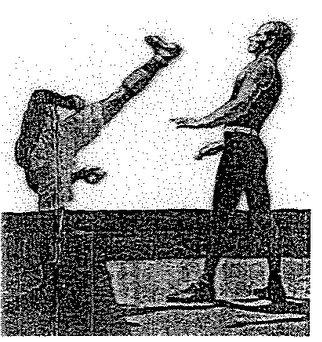
(Burlamaqui demonstrates his queixada, 1928).
-
https://www.youtube.com/watch?v=5yIzTvlonys
Jawkick is a special kick of old Carioca; it uses the heel to strike opponent's jaw.
-
Equip LightLegs; step forth with your left leg (preferably from Peneiracao) and throw right heel to opponent's jaw.
This is a high-energy point("Haaaa!").
-
The power of the kick is applied when your heel crushes diagonally down; using the LightLegs and the elastic power of your hips. This is when you apply the vocalization.
The mechanics is Tiger+LightLegs.
-
The kick is used like a jab; ie tactically, it is a jab-kick.
The impact area is either the heel; or the back of your shank. Both work well. The target is opponent's jaw and the effect is a knockout.
Even if you miss his jaw, still, hitting his head properly produces a nerve strangle.
-
As with Pe de panzina and other LightLegs kicks, Jawkick cannot be blocked with opponent's arms (producing a nerve disruption if the tries); thus making it one of the primary frontal weapons of old Capoeiragem.
--
Note that this is neither a sidekick(chapa), nor a hook kick(modern gancho); neither it is the Queixada of modern capoeira. Neither of these three kicks can be done using LightLegs.
This is a special LightLegs-only kick that hits opponent's jaw with your heel (Tiger+LightLegs). You can also hit with the back of your calf (hence the probable old name of this kick, Cannelada).
-
This kick was probably called 'Canelada' in the old parlance.
Burlamaqui (1928) calls it 'queixada'; however, I avoid this name to prevent confusion with the modern Queixada.

(Burlamaqui demonstrates his queixada, 1928).
-
It is possible that this was also the 'Quixim' or 'Quixinho' used by old Bahian capoeira (Angola) schools before Regional; as this is the only was to execute a 'queixada' with LightLegs. For more about LightLegs and old Bahian Capoeira, see my article on that topic.
-
It is also possible that this kick was the source of Regional 'Queixada'; by taking away the LightLegs. However, as I wrote, doing so makes it completely different and a lot weaker kick.
-
Double jawkick
https://www.youtube.com/watch?v=0LAuZo6Xejg
There existed another variant of this kick: A Double jawkick.
-
It is thrown similarly to the single variant:
Equip LightLegs, step with your left leg and throw a right hooking kick with the back of your shank to the lower back of the opponent (kidney area).
This is done using Eagle+LightLegs; and it is a high-energy point("Haaa!").
It arches the opponent backward. Take advantage of his arched position to throw a jawkick with your heel; without landing your leg on the ground, directly from the air! The target is the area between opponent's jaw and neck.
This is done using Tiger+LightLegs; and it is another high-energy point("Haaaa!")
Together, the sound this double kick uses is "HaaaHaaaa!".
---
Due to the opponent's arched position, the double variant jawkick is a lot more powerful than the single one.
In fact, it is outright dangerous; because of opponent's arched position, aside from knocking him out, the second kick will probably subluxate his lumbar spine. In other words, it is almost a backbreaker (for more about backbreakers, read my books on kungfu).
Aside from damaging his back, it might also take the opponent down on the ground - so then you can fall on him to finish him off (see the finish for Banda de frente). This is described in (Dionísio esfacelado: Quilombo dos Palmares from Domício Proença Filho); where the double kick is called 'Correr una chincha'.
-
If you choose to train the Double jawkick, do not forget it can easily injure opponent's spine.
-
The double variant is done very close; by stepping forth and hooking at the kidneys. Tactically(entry-wise), it is a banda, not a jabkick as the single version.
-
https://books.google.cz/books?id=OIlDDwAAQBAJ&pg=PT127&lpg=PT127&dq=correr+uma+chincha&source=bl&ots=OfTfeFY17t&sig=ACfU3U2AsW-MC8p22ZfZFK8VFVRCaAnpHw&hl=cs&sa=X&redir_esc=y#v=onepage&q=correr%20uma%20chincha&f=false
"Golpe de capoeira que consiste em passar a panturrilha com rapidez na altura dos rins do adversario, pelas costas, derubando-o a seguir com uma queixada e a applicao imediata de uma banda."
-banda - pode ser banda de frente, banda de lado, banda de costas, conforme a posicao da queda imposta ao adversario, que resulta em traumatismo agravado pelo peso corpo de quem a aplica ao atirar-se inesperadamente em cima de vitima, calcando-a contra o solo. O termo e tambem,na Umbanda, sinonimo de linha.
This Web Page was Built with PageBreeze Free HTML Editor